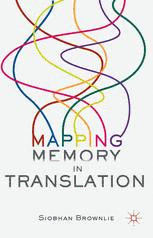Table Of ContentMapping Memory in Translation
This page intentionally left blank
Mapping Memory
in Translation
Siobhan Brownlie
TheUniversityofManchester,UK
MAPPINGMEMORYINTRANSLATION
©SiobhanBrownlie2016
Softcover reprint of the hardcover 1st edition 2016 978-1-137-40894-5
Allrightsreserved.Noreproduction,copyortransmissionofthis
publicationmaybemadewithoutwrittenpermission.Noportionofthis
publicationmaybereproduced,copiedortransmittedsavewithwritten
permission.InaccordancewiththeprovisionsoftheCopyright,Designs
andPatentsAct1988,orunderthetermsofanylicencepermittinglimited
copyingissuedbytheCopyrightLicensingAgency,SaffronHouse,
6–10KirbyStreet,LondonEC1N8TS.
Anypersonwhodoesanyunauthorizedactinrelationtothispublication
maybeliabletocriminalprosecutionandcivilclaimsfordamages.
Firstpublished2016by
PALGRAVEMACMILLAN
Theauthorhasassertedherrighttobeidentifiedastheauthorofthiswork
inaccordancewiththeCopyright,DesignsandPatentsAct1988.
PalgraveMacmillanintheUKisanimprintofMacmillanPublishersLimited,
registeredinEngland,companynumber785998,ofHoundmills,
Basingstoke,Hampshire,RG216XS.
PalgraveMacmillanintheUSisadivisionofNatureAmerica,Inc.,One
NewYorkPlaza,Suite4500,NewYork,NY10004-1562.
PalgraveMacmillanistheglobalacademicimprintoftheabovecompanies
andhascompaniesandrepresentativesthroughouttheworld.
ISBN:978-1-349-68133-4
E-PDFISBN:978–1–137–40895–2
DOI:10.1057/9781137408952
DistributionintheUK,EuropeandtherestoftheworldisbyPalgrave
Macmillan®,adivisionofMacmillanPublishersLimited,registeredin
England,companynumber785998,ofHoundmills,Basingstoke,
HampshireRG216XS.
LibraryofCongressCataloging-in-PublicationData
Names:Brownlie,Siobhan,author.
Title:Mappingmemoryintranslation/SiobhanBrownlie.
Description:Houndmills,Basingstoke,Hampshire;NewYork:Palgrave
Macmillan,2016. | Includesbibliographicalreferencesandindex.
Identifiers:LCCN2015035442
Subjects:LCSH:Translatingandinterpreting—Theory,etc. | Memory. |
Collectivememory. | Memoryinliterature. | Multilingualism. |
Languageandculture. | Languageandlanguages.
Classification:LCCP306.2.B762016 | DDC418/.02—dc23
LCrecordavailableathttp://lccn.loc.gov/2015035442
AcataloguerecordforthebookisavailablefromtheBritishLibrary.
Contents
ListofFiguresandTables vi
Acknowledgements vii
Preface–Casestudy:TwoversionsoftheTreatyofWaitangi viii
1 TranslationandMemory 1
2 PersonalMemory 19
Casestudy:TranslatingKatherineMansfield’sautobiographical
shortstories
3 GroupMemoryandElectronicMemory 47
Casestudy1:Proz.commersandelectronictools
Casestudy2:Thecommunityoffeministtranslators
4 TextualMemory 75
Casestudy1:RetranslationofZola’sNana
Casestudy2:Anetworkofgreathistoricaldocuments
5 NationalandTransnationalMemory 106
Casestudy:ThetranslationofSirWalterScott
6 Traditions 126
Casestudy:CEDAW(ConventionfortheEliminationofAll
FormsofDiscriminationAgainstWomen)andSaudiArabia
7 InstitutionalMemory 151
Casestudy:EnglishandFrenchtranslatorsattheDGT
(DirectorateGeneralforTranslationoftheEuropean
Commission)
8 CosmopolitanConnectiveMemory 182
Casestudy:‘DoYouHearthePeopleSing?’fromLesMisérables
FinalWords 207
Notes 210
References 213
Index 226
v
Figures and Tables
Figures
1 Bilingualsupermarketsign,Kaitaia,NorthNewZealand,
January2014(photobyauthor) xiii
4.1 TheDeclarationofArbroathof6April1320showingits
materialappearance(withpermissionofNationalRecords
ofScotland) 101
5.1 PubIvanhoé,Honfleur,France(withpermissionof
O.Lelaidier) 118
8.1 Useofthesongtitleasasloganandbanner.HongKong
protestsfordemocracy,2014(withpermissionof
EuropeanPressphotoAgency) 189
Tables
6.1 CEDAWperiodicreviewdocumentsstudied 135
vi
Acknowledgements
I would like to thank the following individuals and institutions for
theircontributionandsupportinmywritingofthismonograph:Eman
Almutairi, Manal Alzahrani, Ying-Fang Hsu, Olivier Lelaidier, Olivia
Middleton,FrançoisePellan,Cheng-IanShyu,UrsulaTidd,Huan-Chun
Wu, an anonymous reader for Palgrave Macmillan, the English and
French Departments of the Directorate General for Translation at the
European Commission, the School of Arts, Languages and Cultures at
theUniversityofManchester,UK,andthePalgraveproductionteam.
vii
Preface
TwoVersionsoftheTreatyofWaitangi
Growing up in New Zealand in the 1970s, I was very aware of the
marches and occupations undertaken by the indigenous people, the
Maori, to protest against loss of their land since colonial times. It was
only much later that I learnt that the story of the Maori and their
landwasfundamentallyanarrativeoftranslationandmemory.Iteven
seemsthatmybackgroundinvariouswayshaschannelledmyinterest
in the intersection of translation with memory. Before introducingthe
monographmoreformally,letmefirstgivethereaderaglimpseofthe
fascinating story of the Treaty of Waitangi, which has shaped the his-
tory of New Zealand to this day. This story will serve to highlight how
thetranslation/memorynexuscanbeimportantandthereforeisworth
studying.
The foundational document of modern New Zealand, the Treaty
of Waitangi, is the document by which the British Crown obtained
sovereignty of the country, making New Zealand into a British colony.
TheMaorichiefssignedthetreatyatagreatgatheringatWaitangiinthe
NorthIslandinFebruary1840.BecausetheMaoriwerenotproficientin
English, the treaty had to be translated into the Maori language. The
Maori version Te Tiriti o Waitangi was produced by Reverend Williams
and his son just the night before the meeting with the Maori chiefs.
Hereweencounterthetranslationissues.
In the Maori translation there are in fact some crucial differences in
meaningcomparedwiththeEnglishversion.Whiletangentiallyrelated,
the two texts are quite different in meaning. Here are the two most
significantdifferencesforposterity:
Article1
English version: the Maori leaders are to give the British Queen
Victoria‘alltherightsandpowersofsovereignty’overtheland.
Maoriversion:Maorileadersaretogivethequeen‘tekawanatanga
katoa’–thecompletegovernmentovertheland.
viii
Preface ix
Article2
English version: Maori people are guaranteed ‘exclusive and undis-
turbedpossessionoftheirlands,estates,forests,fisheries,andother
properties’.
Maori version: Maori are guaranteed ‘te tino rangatiratanga’ – the
unqualified exercise of their chieftainship over their lands, villages
andalltheirtreasures.(Orange2013,38,myemphasis)
‘Kawanatanga’wasaneologismatthetime,relatedto‘governor’,suchas
theBritishgovernorofNewSouthWalesinAustralia,orPontiusPilate,
Roman governor in the Bible. ‘Rangatiratanga’ was a term of Maori
derivation, relating to chiefly power; it was also used in Maori biblical
texts to refer to God’s ‘kingdom’. The word had been used in the 1835
Declaration of Independence to refer to New Zealand’s ‘independence’
(Orange 1997). Orange (1997, 41) concludes that based on the Maori
text: ‘Maori might well have assumed that their sovereign rights were
actuallybeingconfirmedinreturnforalimitedconcessionofpowerin
kawanatanga[governorship]’.
Certainlythereisafundamentalquestionofculturaldifferencehere,
inthattwoverydifferentworldviewsarebroughtintocontact.Thetra-
ditionalMaoriviewoflandwasthatitcouldneverbealienatedfromthe
peoplewhowerebornthere,thuspermanentsovereigntyorownership
byanotherpeoplewasanimpossibility:
A tribe had authority over a given area, but the land belonged to
the past, present, and future generations. It was not an alienable
commodity. People were part of the land; they could not own it.
(Fenton&Moon2002,35)
For many Maori, understanding of the treaty text would have been
coloured by this conception. The English treaty text uses British terms
andconcepts(sovereignty,ownershipofland),whichintheMaoritext
are substituted by very different Maori terms/concepts (kawanatanga –
governorship; rangatiratanga – chiefly authority over land). So one
couldsaythata‘culturaltranslation’thataimstoexplaintheEuropean
concepts to the Maori has certainly not been undertaken in the text.
Theadditionalquestioniswhethermanipulationenteredintothetrans-
lationprocess.IfamorepowerfulMaoriexpressionincludingtheterm
‘mana’, connoting supreme authority and spiritual chiefly power, had
beenusedtoexpresswhatwasbeingtransferredtotheBritishmonarch,

